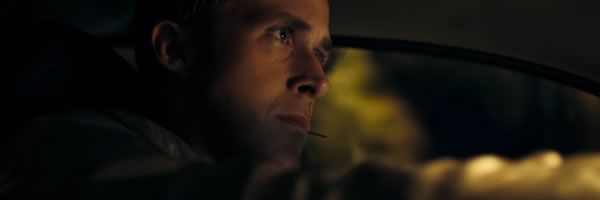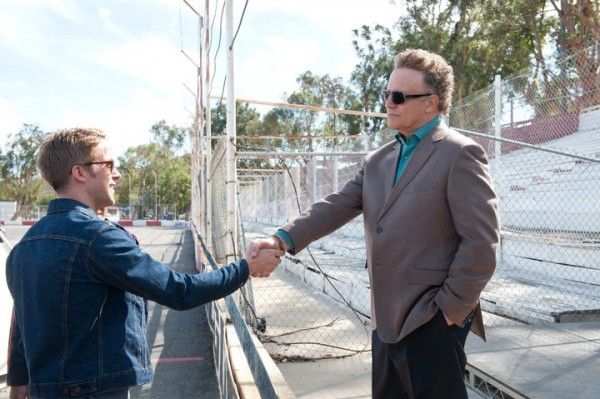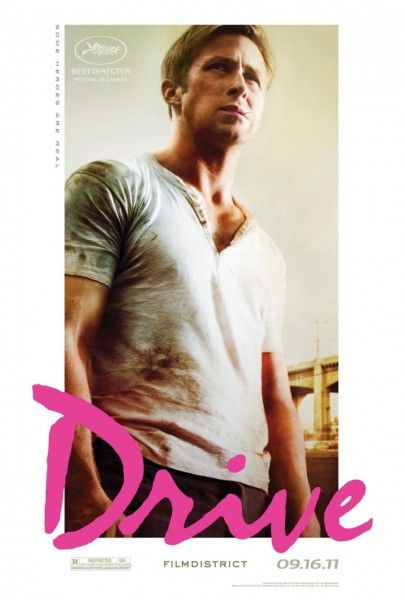Drive is a truly unique and original dramatic thriller, as seen through the eyes of intriguing Danish filmmaker Nicolas Winding Refn and brought to life by its talented cast, including Ryan Gosling, Carey Mulligan, Albert Brooks and Ron Perlman. The Driver (Gosling) is a Los Angeles wheelman for hire, stunt driving for movie productions by day while steering getaway vehicles for armed heists by night. When his beautiful neighbor Irene (Mulligan) catches his eye, and what was supposed to be an easy job spins out of control, he finds himself wanting to protect the girl that he loves, no matter the cost.
At the film’s press day, actor Ryan Gosling talked about how he saw this film as a violent John Hughes movie that he could live out his Rambo fantasizes in, what made Nicolas Refn the perfect director to handle this material, that he credits the REO Speedwagon song “I Can’t Fight This Feeling Anymore” with getting the film made, how learning the stunt driving was the best two weeks of prep he’s ever had, and that co-star Carey Mulligan was his partner in crime. He also talked about how he always looks for directors that he can build a relationship with, that his fantasy of robbing banks led him to play a motorcycle stunt driver in The Place Beyond the Pines (with Blue Valentine director Derek Cianfrance), and that his next project will be The Gangster Squad for director Ruben Fleischer (Zombieland).
Question: How did you come to get this role?
RYAN GOSLING: (Producer) Marc Platt gave me the script and said that he wanted to produce it with me, and that any director I wanted, he would support. So, I had to find the right director. My personal feelings about the script were that I’ve always wanted to see a violent John Hughes movie, and I always thought that, if Pretty in Pink had a head smashing, it would be perfect. And then, on top of that, when I was a kid and I first saw First Blood, it put a spell on me and I thought I was Rambo. I went to school the next day with my Fisher Price Houdini kit filled with steak knives and threw them at all the kids at recess. I got suspended, which I should have been. I learned my lesson and I’m sorry, but my parents then put a leash on me and said, “This kid can’t watch movies because they put a spell on him.”
So, I could only watch Bible movies, National Geographic movies, and Abbott & Costello movies. Meanwhile, all those movies are kind of violent, so it didn’t really work, but I see what they were going for. Anyway, my point is that, when I read this script and I was looking at this character’s behavior – he was going around acting like a maniac – I thought, “This is somebody who has seen too many movies.” Because he was a stunt man, it seemed that we could go deeper into that idea. He had seen too many films and basically started to become the hero of the movie of his life. I thought that could be implemented into this script, but I needed a director that could help me achieve that.
What was it about Nicolas Winding Refn that made him the perfect director?
GOSLING: I see a lot of movies, and I went to see Valhalla Rising. His films are very deeply routed in mythology and they feel like fairy tales, and I felt like the movie should have a fairy tale quality because it’s set in Los Angeles, which is a fairy tale land, based on fantasy. The Driver is more like a knight, in his mind anyway, and Irene (Carey Mulligan) is the damsel in distress, Nino (Ron Perlman) is the dragon, and Bernie Rose (Albert Brooks) is the evil wizard. I was watching his films and seeing that they were like Grimm’s brothers fairy tales. They’re also very personal. He’s a fetishist. He only shoots what he wants to see. He doesn’t shoot anything that he doesn’t actually find erotic. I appreciate how personal his films are, and that they have a real identity. They don’t try to please anyone, but him. I wanted this movie to be something that had personality and an identity, and that you wanted to be in the movie theater to see. When I saw Valhalla Rising, and the guy cuts open the stomach of his friend and starts showing him his own guts, and everybody in the theater starts hitting each other, laughing and freaking out, whether you liked it or not, I know that you were happy to see it in the theater. That’s not the kind of thing you want to see at home. I wanted to make a movie that you wanted to go to the movie theater to see.
Did you do your own stunt driving in this?
GOSLING: Some of it.
GOSLING: The really cool stuff, I didn’t do. But, the cool stuff, I did. The really cool stuff is (stunt double/driver) Jeremy Fry, who’s about as good as it gets.
Did you have training for the driving that you did?
GOSLING: Yeah, I spent two weeks going to this church parking lot with (stunt coordinator) Darrin Prescott. Every time we got there, there would be a new Camaro or a new Mustang, and we would ride it to the rims. When it was on fire or smoking, or just wouldn’t move, some guy would come and take it away and fix it, and we would go home. It was the best two weeks of prep that I’ve ever had.
Did you get to keep the driving gloves and satin scorpion jacket?
GOSLING: Yeah, I made those, so I have many versions of them.
So, you’re a renaissance man, then?
GOSLING: Yeah, or a weirdo. I didn’t sew them.
Do you have a real appreciation for cars now, or was that always there?
GOSLING: I never really cared about cars. I still don’t. I worked on the car that I drive in the movie, so I have an affection for it, but just for it. And even it rubs me the wrong way because I worked with this guy Pedro, who is a great guy, but he changed my transmission and it really stinks. I did everything on the car except for that, and he knew it. On the last day, when I was going to finish the car, I came in and he had changed my transmission. He thought it was really funny, but it cut me. Now, I can’t say I did everything on the car, and he thinks that’s funny. I don’t know anything about transmissions because I didn’t change mine, so thanks, Pedro.
Being on set versus the final product, what’s different and what’s similar to what you had envisioned?
GOSLING: This movie wouldn’t have happened, if REO Speedwagon hadn’t come on the radio when I was driving Nicolas home from our first terrible meeting. The movie wasn’t happening. It was a bad meeting. It was a bad date. No one was getting any action. So, we wanted to just go home. Suddenly, REO Speedwagon came on the radio, and he started crying, and then he started singing the song, at the top of his lungs. He said, “This is it. This movie is about a guy who can’t feel anything, unless he’s driving around, listening to pop music.” The movie was conceived in my car. He and I creatively mated and created this movie baby, and then we had to raise it together. The film is a great representation of what the process of making it was like. The way we made the movie informed what it was. We would cut out all the dialogue and shoot all day, and then go home and edit it, and then drive around all night, listening to music and going to the 101 Diner, and talking about life and music and movies. That would influence what we shot the next day.
It had this dreamlike quality, while we were shooting it, so that’s what the movie feels like. It feels like we didn’t have a plan, going into it. Something happened in the car when REO Speedwagon came on, and we were chasing that the whole time, trying to figure out what happened. We both felt that way. I felt the same way, that it should be about this guy that drives around, listening to music. Nicolas is from Copenhagen and I’m from Canada. How did that happen? Why were we both having the same idea? Why did REO Speedwagon come on the radio? Were we supposed to make this movie, or were we crazy? Have we seen too many movies? It was a very unique movie-making experience.
What REO Speedwagon song was the catalyst for this?
GOSLING: “I Can’t Fight this Feeling Anymore”
Was this a character that you were just able to leave on set, or did he stick with you? Was that why you decided to break up a fight in the street recently?
GOSLING: No, that was just stupid. Did I take the character home? I’m not a good enough actor to become a character and be that person for the duration of shooting. But, what I can do is turn up the parts of myself that are like that character, and turn down the parts that aren’t. What I have in common with that character is amplified while I’m shooting. In this case, making this film, it was very peaceful because the character was very introverted and a watcher. I gave myself permission to do that while we were shooting. I wanted to be in character.
What was it like to work so intensively with Albert Brooks and Ron Perlman?
GOSLING: Ron Perlman is just an endless well of great lines. For instance, I was trying to drown him in the ocean and every time I pushed him into the water, the tide would go out and I was just pushing his face into the mud. And then, the wave would come back and knock us both over, and we would have to start again. We did it all night, until the sun came up. He tore his ACL. When we finally got the one shot that we needed, where I put him under for long enough, he stood up and screamed to Nicolas, “Yo Nicky, that was the one. If you don’t like that, you don’t like ice cream, motherfucker!” And then, he snapped and limped back to his trailer, and didn’t come back out. That’s what it’s like working with Ron Perlman, all the time. Albert Brooks was the only person we wanted to play Bernie Rose. He had to do it. We didn’t know what we were going to do, if he didn’t. So, he came on and not only played that character, but owned that character, to the point that he possessed it and you couldn’t see anybody else playing that part.
What was it like to work with Carey Mulligan and develop your chemistry?
GOSLING: She was my partner in crime because she secretly didn’t want to talk either. We would come to set in the morning and Nicolas would be like, “Okay, so what do you want to say?” And Carey would say, “Well, I don’t want to say this,” and I’d say, “Okay, well, I don’t want to say that,” until we weren’t saying anything and Nicolas said, “Okay, great, let’s shoot it.” We knew what we were supposed to say, and those lines were in there, even if we weren’t saying them. Nicolas really encouraged us. He would come up to us before takes, and hug us and hold us. Sometimes he would hold you for five minutes, until you stopped resisting his hug. Even if you thought you’d submitted to it, you hadn’t. And when you were totally relaxed, he would then look at you with tears in his eyes and say, “Go with god.” And then, he’d say, “Action!” That helped.
After having had such a bad initial meeting with Nicolas, once you finally did get on set with him, what was it about his acting style that you enjoyed so much that made you want to do two more films with him?
GOSLING: He only shoots what he wants to see, so there’s nothing wasteful about it. He doesn’t do coverage to cover himself. He only puts in the frame what he wants to see, and he only shoots what he wants to see. His films have a very strong identity because of that. What I feel so lucky about is that he and I share the same fantasies. We can both make a film that’s personal to us, and not have to compromise. We were always searching for the same thing, and I think that’s rare. I found that in Nicolas, and I found that in Derek [Cianfrance], who did Blue Valentine, and who I just did The Place Beyond the Pines with. I feel very fortunate to have found them, and now I can’t wait to make more movies with them because we can start to cut out the fat.
Is something that you look for, when deciding on what projects you want to sign on for, directors that you really can build that relationship with?
GOSLING: Yeah. There’s no point in making a movie, if you’re not on the same page as the director. There are reasons to make movies other than that, and you can make them for those reasons. But, if you care how it turns out, you have to be on the same page as the director. I used to think that you needed conflict with the director, and that you were supposed to be combative, so that out of that conflict could come creativity, but I don’t believe that anymore.
What made you want to do The Place Beyond the Pines, where you’re playing a motorcycle stunt driver?
GOSLING: When I made this film, I didn’t want to make a movie about stunts and going fast. I wanted to make a movie about just driving. I like to drive, but I don’t necessarily need to tear through town. I just like being in the car. I like that you can get in the car and get out, and not remember the trip. As far as Pines goes, I’ve always had this fantasy about robbing banks, but I’m scared of jail. I’ll never do it, but I would, if I didn’t have to go to jail. I don’t know if you know how it works – and I’m not condoning this or pushing it, in any way – but banks have to give you the money. They’re told to give it to you. All you have to do is ask for it. You don’t have to have a gun. You just have to say, “Hey, give me the money,” and they have to. So, you can get the money. It’s just about how you get away with it. I had this fantasy that I would get on a motorcycle and drive into the back of a U-Haul parked around the corner, and they would be looking for a guy on a motorcycle, not a guy in a U-Haul. And, I told that to the director and he said, “You’ve got to be kidding me. I just wrote a script about that.” So, I had to do that. Now, there’s a theme, but I wasn’t aware of it, at the time.
What is the rest of this year like for you, as far as what you’re going to be working on next?
GOSLING: I’m about to start a film called The Gangster Squad, which is a 1950's gangster picture with a bunch of great actors and directed by Ruben Fleischer.



